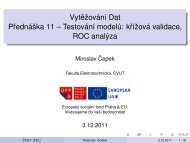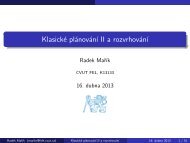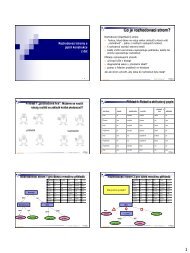Classical Planning
Classical Planning
Classical Planning
You also want an ePaper? Increase the reach of your titles
YUMPU automatically turns print PDFs into web optimized ePapers that Google loves.
<strong>Classical</strong> <strong>Planning</strong><br />
Radek Maˇrík<br />
CVUT FEL, K13133<br />
15. dubna 2013<br />
Radek Maˇrík (marikr@felk.cvut.cz) <strong>Classical</strong> <strong>Planning</strong> 15. dubna 2013 1 / 71
Content<br />
1 Concept of AI <strong>Planning</strong><br />
Definition<br />
Conceptual Model<br />
Methodology of Planners<br />
2 Representation<br />
STRIPS<br />
PDDL<br />
3 <strong>Planning</strong> Methods<br />
Logics and Searching<br />
State Space<br />
Radek Maˇrík (marikr@felk.cvut.cz) <strong>Classical</strong> <strong>Planning</strong> 15. dubna 2013 2 / 71
Concept of Plan [Nau09]<br />
Concept of AI <strong>Planning</strong> Definition<br />
Plan<br />
many definitions and aspects ....<br />
A scheme, program, or method worked out beforehand for the<br />
accomplishment of an objective.<br />
Radek Maˇrík (marikr@felk.cvut.cz) <strong>Classical</strong> <strong>Planning</strong> 15. dubna 2013 4 / 71
Plan Definition<br />
<strong>Planning</strong><br />
Concept of AI <strong>Planning</strong> Definition<br />
[Nau09, Pec10]<br />
Reasoning about about hypothetical interaction among the agent and<br />
the environment with respect to a given task.<br />
Motivation of the planning process is to reason about possible course<br />
of actions that will change the environment in order to reach the goal<br />
(task)<br />
Radek Maˇrík (marikr@felk.cvut.cz) <strong>Classical</strong> <strong>Planning</strong> 15. dubna 2013 5 / 71
Concept of AI <strong>Planning</strong> Definition<br />
<strong>Planning</strong> and Scheduling [Nau09]<br />
Scheduling . . . assigns in time resources to separate processes,<br />
<strong>Planning</strong> . . . considers possible interaction among components of<br />
plan.<br />
<strong>Planning</strong><br />
Given: the initial state, goal state, operators.<br />
Find a sequence of operators that will reach the goal state from the<br />
initial state<br />
Select appropriate actions, arrange the actions and consider the<br />
causalities<br />
Scheduling<br />
Given: resources, actions and constraints.<br />
Form an appropriate schedule that meets the constraints<br />
Arrange the actions, assign resources and satisfy the constrains.<br />
Radek Maˇrík (marikr@felk.cvut.cz) <strong>Classical</strong> <strong>Planning</strong> 15. dubna 2013 6 / 71
Concept of AI <strong>Planning</strong> Definition<br />
Real Applications - Space Exploration [Nau09]<br />
Projects<br />
Autonomous planning, scheduling, control<br />
NASA: JPL and Ames.<br />
Remote Agent Experiment (REX)<br />
Deep Space 1.<br />
Mars Exploration Rover (MER)<br />
Radek Maˇrík (marikr@felk.cvut.cz) <strong>Classical</strong> <strong>Planning</strong> 15. dubna 2013 7 / 71
Concept of AI <strong>Planning</strong> Conceptual Model<br />
Conceptual Model of <strong>Planning</strong> I [Nau09]<br />
Environment<br />
State transition system<br />
Σ = (S, A, E, γ)<br />
S = {states}<br />
A = {actions}<br />
E = {exogenous events}<br />
γ =<br />
{state-transition function}<br />
Radek Maˇrík (marikr@felk.cvut.cz) <strong>Classical</strong> <strong>Planning</strong> 15. dubna 2013 9 / 71
Concept of AI <strong>Planning</strong> Conceptual Model<br />
The Dock-Worker Robots (DWR) Domain [Wic11]<br />
<strong>Planning</strong> procedure illustration<br />
harbour with several locations<br />
(docks),<br />
docked ships,<br />
storage areas for containers,<br />
parking areas for<br />
trains,<br />
trucks<br />
Goal:<br />
cranes to load and unload<br />
ships.<br />
robot carts to move<br />
containers around<br />
Port of Hamburg<br />
Radek Maˇrík (marikr@felk.cvut.cz) <strong>Classical</strong> <strong>Planning</strong> 15. dubna 2013 10 / 71
Concept of AI <strong>Planning</strong> Conceptual Model<br />
State Transition System Example [Nau09]<br />
State Trainsition System<br />
Σ = (S, A, E, γ)<br />
S = {states}<br />
A = {actions}<br />
E = {exogenous events}<br />
γ = S × (A ∪ E) → 2 S<br />
System Instance<br />
S = {s0, s1, . . . , s5}<br />
A = {move1, move2, put,<br />
take, load, unload}<br />
E = {}<br />
γ = {see arrows}<br />
Radek Maˇrík (marikr@felk.cvut.cz) <strong>Classical</strong> <strong>Planning</strong> 15. dubna 2013 11 / 71
Concept of AI <strong>Planning</strong> Conceptual Model<br />
Conceptual Model of <strong>Planning</strong> I [Nau09]<br />
Controller<br />
observation function<br />
h : S → O<br />
given observation o ∈ O<br />
produces action a ∈ A<br />
Planner<br />
produces plans<br />
instructions to the<br />
controller<br />
Radek Maˇrík (marikr@felk.cvut.cz) <strong>Classical</strong> <strong>Planning</strong> 15. dubna 2013 12 / 71
<strong>Planning</strong> Task [Nau09]<br />
Concept of AI <strong>Planning</strong> Conceptual Model<br />
<strong>Planning</strong> problem<br />
System description Σ<br />
Initial state or set of<br />
states<br />
Initial state = s0<br />
Objective<br />
Goal state,<br />
set of goal states,<br />
set of tasks,<br />
“trajectory” of states,<br />
objective function<br />
Goal state = s5<br />
Radek Maˇrík (marikr@felk.cvut.cz) <strong>Classical</strong> <strong>Planning</strong> 15. dubna 2013 13 / 71
Plan [Nau09]<br />
Concept of AI <strong>Planning</strong> Conceptual Model<br />
<strong>Classical</strong> plan<br />
Policy:<br />
a sequence of actions<br />
< take, move1, load, move2 ><br />
partial function from S into A<br />
{(s0, take), (s1, move1),<br />
(s3, load), (s4, move2)}<br />
Radek Maˇrík (marikr@felk.cvut.cz) <strong>Classical</strong> <strong>Planning</strong> 15. dubna 2013 14 / 71
Types of Planners [Nau09]<br />
Domain-specific<br />
Concept of AI <strong>Planning</strong> Methodology of Planners<br />
Made or tuned for a specific domain<br />
Won’t work well (if at all) in any other domain<br />
Most successful real-world planning systems work this way<br />
Domain-independent<br />
Works in any planning domain, in principle,<br />
Uses no domain-specific knowledge except the definitions of the basic<br />
actions<br />
In practice, not feasible to develop domain-independent planners that<br />
work in every possible domain,<br />
Make simplifying assumptions to restrict the set of domains<br />
<strong>Classical</strong> planning<br />
Historical focus of most automated-planning research<br />
Radek Maˇrík (marikr@felk.cvut.cz) <strong>Classical</strong> <strong>Planning</strong> 15. dubna 2013 16 / 71
Restrictive Assumptions [Nau09]<br />
Concept of AI <strong>Planning</strong> Methodology of Planners<br />
A0: Finite system<br />
finitely many states, actions, events<br />
A1: Fully observable<br />
the controller always Σ’s current state<br />
A2: Deterministic<br />
each action has only one outcome<br />
A3: Static (no exogenous events)<br />
no changes but the controller’s actions<br />
A4: Attainment goals<br />
existency a set of goal states Sg<br />
A5: Sequential plans<br />
a plan is a linearly ordered sequence of actions < a0, a1, . . . , an ><br />
A6: Implicit time<br />
no time durations; linear sequence of instantaneous states<br />
A7: Off-line planning<br />
planner doesn’t know the execution status<br />
Radek Maˇrík (marikr@felk.cvut.cz) <strong>Classical</strong> <strong>Planning</strong> 15. dubna 2013 17 / 71
<strong>Classical</strong> <strong>Planning</strong> [Nau09]<br />
Concept of AI <strong>Planning</strong> Methodology of Planners<br />
Requires all 8 restrictive assumptions<br />
Offline generation of action sequences for a deterministic, static, finite<br />
system, with complete knowledge, attainment goals, and implicit time.<br />
Reduces to the following problem:<br />
Given (Σ, s0, Sg )<br />
Find a sequence of actions π =< a0, a1, . . . , an >, that produces a<br />
sequence of state transitions < s0, s1, . . . , sn > such that sn ∈ Sg .<br />
This is just path-searching in a graph<br />
Nodes = states<br />
Edges = actions<br />
Is this trivial?<br />
Radek Maˇrík (marikr@felk.cvut.cz) <strong>Classical</strong> <strong>Planning</strong> 15. dubna 2013 18 / 71
Concept of AI <strong>Planning</strong> Methodology of Planners<br />
<strong>Classical</strong> <strong>Planning</strong> - example [Nau09]<br />
Reality<br />
Cargo Transportation by Planes<br />
10 airports<br />
50 aircrafts<br />
200 pieces of cargo<br />
number of states 10 50 × (50 + 10) 200 ≈ 10 405<br />
minimum number of actions 50 × 9 = 450<br />
all cargo located on airpots with no planes<br />
maximum number of actions 50 200 × 9 ≈ 10 340<br />
all cargo and aircrafts in one airport<br />
The number of particles in the universe is about 10 87<br />
Automated planning research<br />
classical planning mostly<br />
dozens (hundreds) of different aglorithms<br />
Radek Maˇrík (marikr@felk.cvut.cz) <strong>Classical</strong> <strong>Planning</strong> 15. dubna 2013 19 / 71
Representation STRIPS<br />
<strong>Classical</strong> Representatons [Wic11]<br />
<strong>Planning</strong> as Theorem Proving<br />
world state is a set of propositions<br />
actions contains applicability conditions as a set of formulas and effects<br />
in a form of formulas added or removed if a given action is applied,<br />
STRIPS representation<br />
similar to the propositional representation<br />
literals of the first order are used instead of propositions<br />
a representation using state variables<br />
state is k-tuple of state variables {x1, . . . , xk}<br />
action is a partial function over states<br />
Radek Maˇrík (marikr@felk.cvut.cz) <strong>Classical</strong> <strong>Planning</strong> 15. dubna 2013 21 / 71
Representation STRIPS<br />
Factored State Representation<br />
World State Representation<br />
atomic . . . state is a single indivisible entity<br />
factored . . . state is a collection of variables<br />
Radek Maˇrík (marikr@felk.cvut.cz) <strong>Classical</strong> <strong>Planning</strong> 15. dubna 2013 22 / 71
Representation STRIPS<br />
STRIPS - state representation [Wic11]<br />
Let L be a first-order language<br />
with finitely many predicate symbols,<br />
with finitely many constant symbols,<br />
and no function symbols.<br />
A state in a STRIPS planning domain is a set of ground atoms of<br />
L:<br />
(ground) atom p holds in state s ⇔ p ∈ s<br />
s satisfies a set of (ground) literals g (s |= g) if<br />
every positive literal in g is in s<br />
every negative literal in g is not in s<br />
Radek Maˇrík (marikr@felk.cvut.cz) <strong>Classical</strong> <strong>Planning</strong> 15. dubna 2013 23 / 71
STRIPS State: example [Wic11]<br />
State in DWR Domain<br />
Representation STRIPS<br />
state = {attached(p1, loc1),<br />
attached(p2, loc1),<br />
in(c1, p1), in(c3, p1),<br />
top(c3, p1), on(c3, c1),<br />
on(c1, pallet), in(c2, p2),<br />
top(c2, p2), on(c2, pallet),<br />
belong(crane1, loc1),<br />
empty(crane1),<br />
adjacent(loc1, loc2),<br />
adjacent(loc2, loc1),<br />
at(r1, loc2),<br />
occupied(loc2),<br />
unloaded(r1)}<br />
Radek Maˇrík (marikr@felk.cvut.cz) <strong>Classical</strong> <strong>Planning</strong> 15. dubna 2013 24 / 71
Representation STRIPS<br />
STRIPS - Operator and Action Representations [Wic11]<br />
A planning operator in a STRIPS planning domain is a triple<br />
o = (name(o), precond(o), effects(o)),<br />
the name of the operator name(o)<br />
is a syntactic expression of the form n(x1, . . . , xk),<br />
where n is a (unique) symbol<br />
and x1, . . . , xk are all the variables,<br />
that appear in o, and<br />
the preconditions precond(o) and the effects effects(o) of the operator<br />
are sets of literals.<br />
An action in a STRIPS planning domain is a ground instance of a<br />
planning operator.<br />
Radek Maˇrík (marikr@felk.cvut.cz) <strong>Classical</strong> <strong>Planning</strong> 15. dubna 2013 25 / 71
Representation STRIPS<br />
STRIPS Operator: example [Wic11]<br />
move(r, l, m)<br />
robot r moves from location l to neighboring location m<br />
precond: adjacent(l, m), at(r, l), ¬occupied(m)<br />
effects: at(r, m), occupied(m), ¬occupied(l), ¬at(r, l)<br />
load(k, l, c, r)<br />
crane k in location l loads container c on robot r<br />
precond: belong(k, l), holding(k, c), at(r, l), unloaded(r)<br />
effects: empty(k), ¬holding(k, c), loaded(r, c), ¬unloaded(r)<br />
put(k, l, c, d, p)<br />
crane k in location l puts container c onto d in pile p<br />
precond: belong(k, l), attached(p, l), holding(k, c), top(d, p)<br />
effects:<br />
¬holding(k, c), empty(k), in(c, p), top(c, p), on(c, d), ¬top(d, p)<br />
Radek Maˇrík (marikr@felk.cvut.cz) <strong>Classical</strong> <strong>Planning</strong> 15. dubna 2013 26 / 71
Representation STRIPS<br />
Applicability and State Transitions [Wic11]<br />
Let L be a set of literals<br />
L + is the set of atoms that are positive literals in L,<br />
L − is the set of all atoms whose negations are in L<br />
Let a be an action and s a state.<br />
Then a is applicable in s ⇔:<br />
precond + (a) ⊆ s; and<br />
precond − (a) ∩ s == {}<br />
The state transition function γ for an applicable action a in state s is<br />
defined as:<br />
γ(s, a) = (s − effects − (a)) ∪ effects + (a)<br />
Radek Maˇrík (marikr@felk.cvut.cz) <strong>Classical</strong> <strong>Planning</strong> 15. dubna 2013 27 / 71
Representation STRIPS<br />
STRIPS: <strong>Planning</strong> Domain [Wic11]<br />
Let L be a function-free first-order language.<br />
STRIPS planning domain on L is a restricted state-transition<br />
system Σ = (S, A, γ) such that:<br />
S is a set of STRIPS states, i.e. sets of ground atoms,<br />
A is a set of ground instances of some STRIPSplanning operators O<br />
γ : S × A → S where<br />
γ(s, a) = (s − effects − (a)) ∪ effects + (a) if a is applicable in s<br />
γ(s, a) = undefined otherwise<br />
S is closed under γ<br />
Radek Maˇrík (marikr@felk.cvut.cz) <strong>Classical</strong> <strong>Planning</strong> 15. dubna 2013 28 / 71
Representation STRIPS<br />
STRIPS: <strong>Planning</strong> Problem [Wic11]<br />
A STRIPS planning problem is a triple P = (Σ, si, g) where:<br />
Σ = (S, A, γ) is a STRIPS planning domain on some first-order<br />
language L<br />
si ∈ S is the initial state<br />
g is a set of ground literals describing the goal<br />
such that the set of goal states is<br />
Sg = {s ∈ S|s |= g}<br />
Radek Maˇrík (marikr@felk.cvut.cz) <strong>Classical</strong> <strong>Planning</strong> 15. dubna 2013 29 / 71
Representation STRIPS<br />
STRIPS <strong>Planning</strong> Problem: DWR Example [Wic11]<br />
DWR planning problem<br />
Σ: STRIPS planning domain DWR<br />
si: any state<br />
s0 = {attached(pile, loc1),<br />
in(cont, pile), top(cont, pile),<br />
on(cont, pallet), belong(crane, loc1),<br />
empty(crane), adjacent(loc1, loc2),<br />
adjacent(loc2, loc1),<br />
at(robot, loc2),<br />
occupied(loc2),<br />
unloaded(robot)}<br />
g ⊂ L<br />
g = {¬unloaded(robot),<br />
at(robot, loc2)}<br />
tj. Sg = {s5}<br />
Radek Maˇrík (marikr@felk.cvut.cz) <strong>Classical</strong> <strong>Planning</strong> 15. dubna 2013 30 / 71
Overview of PDDL [Wic11]<br />
Representation PDDL<br />
<strong>Planning</strong> Domain Definition Language (PDDL)<br />
http://cs-www.cs.yale.edu/homes/dvm/<br />
language features (verze 1.x):<br />
basic STRIPS-style actions<br />
various extensions as explicit requirements<br />
used to define:<br />
planning domains:<br />
requirements,<br />
types,<br />
predicates,<br />
possible actions.<br />
planning problems:<br />
objects,<br />
rigid and fluent relations,<br />
initial situation,<br />
goal description.<br />
the current version is 3.x<br />
Radek Maˇrík (marikr@felk.cvut.cz) <strong>Classical</strong> <strong>Planning</strong> 15. dubna 2013 32 / 71
Representation PDDL<br />
Monkey <strong>Planning</strong> Domain<br />
(define (domain MONKEY)<br />
(:requirements :strips :typing)<br />
(:types monkey box location fruit)<br />
(:predicates<br />
(isClear ?b - box) (onBox ?m - monkey ?b - box)<br />
(onFloor ?m - monkey) (atM ?m - monkey ?loc - location)<br />
(atB ?b - box ?loc - location) (atF ?f - fruit ?loc - location)<br />
(hasFruit ?m - monkey ?fruit))<br />
(:action GOTO<br />
:parameters (?m - monkey ?loc1 ?loc2 - location)<br />
:precondition (and (onFloor ?m) (atM ?m ?loc1))<br />
:effect (and (atM ?m ?loc2) (not (atM ?m ?loc1))))<br />
(:action PUSH<br />
:parameters (?m - monkey ?b - box ?loc1 ?loc2 - location)<br />
:precondition (and (onFloor ?m) (atM ?m ?loc1) (atB ?b ?loc1) (isClear ?b))<br />
:effect (and (atM ?m ?loc2) (atB ?b ?loc2)<br />
(not (atM ?m ?loc1))<br />
(not (atB ?b ?loc1))))<br />
(:action CLIMB<br />
:parameters (?m - monkey ?b - box ?loc1 - location)<br />
:precondition (and (onFloor ?m) (atM ?m ?loc1) (atB ?b ?loc1) (isClear ?b))<br />
:effect (and (onBox ?m ?b) (not (isClear ?b)) (not (onFloor ?m))) )<br />
(:action GRAB-FRUIT<br />
:parameters (?m - monkey ?b - box ?f - fruit ?loc1 - location)<br />
:precondition (and (onBox ?m ?b) (atB ?b ?loc1) (atF ?f ?loc1))<br />
:effect (and (hasFruit ?m ?f))))<br />
Radek Maˇrík (marikr@felk.cvut.cz) <strong>Classical</strong> <strong>Planning</strong> 15. dubna 2013 33 / 71
Representation PDDL<br />
Monkey <strong>Planning</strong> Problem<br />
(define (problem MONKEY1)<br />
(:domain MONKEY)<br />
(:objects monkeyJudy - monkey<br />
bananas - fruit<br />
boxA - box<br />
locX locY locZ - location)<br />
(:init (and<br />
(onFloor monkeyJudy)<br />
(atM monkeyJudy locX)<br />
(atB boxA locY)<br />
(atF bananas locZ)<br />
(isClear boxA)<br />
)<br />
)<br />
)<br />
(:goal (and (hasFruit monkeyJudy bananas))<br />
Radek Maˇrík (marikr@felk.cvut.cz) <strong>Classical</strong> <strong>Planning</strong> 15. dubna 2013 34 / 71
Representation PDDL<br />
Monkey <strong>Planning</strong> Problem Solution<br />
Begin plan<br />
1 (goto monkeyjudy locx locy)<br />
2 (push monkeyjudy boxa locy locz)<br />
3 (climb monkeyjudy boxa locz)<br />
4 (grab-fruit monkeyjudy boxa bananas locz)<br />
End plan<br />
Radek Maˇrík (marikr@felk.cvut.cz) <strong>Classical</strong> <strong>Planning</strong> 15. dubna 2013 35 / 71
<strong>Planning</strong> Methods Logics and Searching<br />
STRIPS Representation - Example<br />
initial state: start<br />
goal: writeValue(a, 3)<br />
action:<br />
startPlan: PAR []<br />
PRE [start]<br />
ADD [declared(server, a), declared(server, b)]<br />
DEL [start]<br />
connectServer: PAR [A]<br />
PRE [declared(server, A)]<br />
ADD [bound(server,A)]<br />
DEL [declared(server, A)]<br />
writing: PAR [a, 3]<br />
PRE [bound(server,a)]<br />
ADD [writeValue(a, 3)]<br />
DEL []<br />
Radek Maˇrík (marikr@felk.cvut.cz) <strong>Classical</strong> <strong>Planning</strong> 15. dubna 2013 37 / 71
Example Result<br />
goal: writeValue(a,3);<br />
result sequence (plan):<br />
1 start<br />
2 connectServer(a)<br />
3 writing(a, 3)<br />
<strong>Planning</strong> Methods Logics and Searching<br />
Radek Maˇrík (marikr@felk.cvut.cz) <strong>Classical</strong> <strong>Planning</strong> 15. dubna 2013 38 / 71
<strong>Planning</strong> Methods Logics and Searching<br />
<strong>Planning</strong> - depth-first search through logical formulea<br />
% Depth first search<br />
% ==================<br />
depthFirstSearch(AnsPath) :initialState(Init),<br />
depthFirst([Init], AnsPath).<br />
depthFirst([S|_], [S]) :finalState(S),<br />
!.<br />
depthFirst([S|Path], [S|AnsPath]) :extend([S|Path],<br />
S1),<br />
depthFirst([S1, S |Path], AnsPath).<br />
extend([S|Path], S1) :nextState(S,<br />
S1),<br />
not(memberState(S1, [S|Path])).<br />
memberState(S, Path) :member(S,Path).<br />
Radek Maˇrík (marikr@felk.cvut.cz) <strong>Classical</strong> <strong>Planning</strong> 15. dubna 2013 39 / 71
<strong>Planning</strong> Methods Logics and Searching<br />
<strong>Planning</strong> - a problem specification in Prolog<br />
% Farmer, Wolf, Goat, Cabbage<br />
% ===========================<br />
initialState([n,n,n,n]).<br />
finalState([s,s,s,s]).<br />
nextState(S, S1) :- move(S, S1), safe(S1).<br />
move([F, W, G, C], [F1, W, G, C]) :- cross(F, F1).<br />
move([F, F, G, C], [F1, F1, G, C]) :- cross(F, F1).<br />
move([F, W, F, C], [F1, W, F1, C]) :- cross(F, F1).<br />
move([F, W, G, F], [F1, W, G, F1]) :- cross(F, F1).<br />
safe([F, W, G, C]) :- F=G, !; F=W, F=C.<br />
cross(n,s).<br />
cross(s,n).<br />
%------t1(AnsPath)<br />
:- depthFirstSearch(AnsPath).<br />
Radek Maˇrík (marikr@felk.cvut.cz) <strong>Classical</strong> <strong>Planning</strong> 15. dubna 2013 40 / 71
<strong>Planning</strong> Methods State Space<br />
State-Transition Graph Example [Wic11]<br />
Game of Missionaries and Cannibals<br />
move 3 cannibals and 3 missionaries across the river<br />
Whenever the number of cannibals is higher than the number of<br />
missionaries somewhere, the missionaries are cooked and eaten.<br />
Radek Maˇrík (marikr@felk.cvut.cz) <strong>Classical</strong> <strong>Planning</strong> 15. dubna 2013 42 / 71
Preliminaries<br />
[Nau09, Wic11]<br />
Propositional logics<br />
Hill-climbing searching<br />
<strong>Planning</strong> Methods State Space<br />
A ∗ , but a suitable heuristics was missing for decades<br />
Idea:<br />
use of standard searching algorithms<br />
breadth-first,<br />
depth-first,<br />
A ∗<br />
etc.<br />
a planning problem task<br />
searching space is a subspace of state space<br />
nodes represent states of the environment<br />
edges correspond to state transitions<br />
a path through the state space determines a plan<br />
Radek Maˇrík (marikr@felk.cvut.cz) <strong>Classical</strong> <strong>Planning</strong> 15. dubna 2013 43 / 71
<strong>Planning</strong> Methods State Space<br />
<strong>Planning</strong> in State Space - an example [Wic11]<br />
nodes: closed atoms<br />
edges: actions (i.e. closed instances of operators)<br />
Radek Maˇrík (marikr@felk.cvut.cz) <strong>Classical</strong> <strong>Planning</strong> 15. dubna 2013 44 / 71
<strong>Planning</strong> Methods State Space<br />
Forward State-Space Search Algorithm [Wic11]<br />
1 Forward-search(O, s0, g)<br />
1 s ← s0<br />
2 π ← the empty plan<br />
3 loop<br />
1 if s |= g then return π<br />
2 E ← {a|a is a ground instance ∈ O<br />
and precond(a) is satisfied in s}<br />
3 if E == ∅ then return FAILURE<br />
4 a non-deterministic choice of action a ∈ E<br />
5 s ← γ(s, a)<br />
6 π ← π.a<br />
Radek Maˇrík (marikr@felk.cvut.cz) <strong>Classical</strong> <strong>Planning</strong> 15. dubna 2013 45 / 71
<strong>Planning</strong> Methods State Space<br />
State-Space Searching Example 1 [Wic11]<br />
Radek Maˇrík (marikr@felk.cvut.cz) <strong>Classical</strong> <strong>Planning</strong> 15. dubna 2013 46 / 71
<strong>Planning</strong> Methods State Space<br />
State-Space Searching Example 2 [Wic11]<br />
Radek Maˇrík (marikr@felk.cvut.cz) <strong>Classical</strong> <strong>Planning</strong> 15. dubna 2013 47 / 71
<strong>Planning</strong> Methods State Space<br />
State-Space Searching Example 3 [Wic11]<br />
Radek Maˇrík (marikr@felk.cvut.cz) <strong>Classical</strong> <strong>Planning</strong> 15. dubna 2013 48 / 71
<strong>Planning</strong> Methods State Space<br />
State-Space Searching Example 4 [Wic11]<br />
Radek Maˇrík (marikr@felk.cvut.cz) <strong>Classical</strong> <strong>Planning</strong> 15. dubna 2013 49 / 71
<strong>Planning</strong> Methods State Space<br />
State-Space Searching Example 5 [Wic11]<br />
Radek Maˇrík (marikr@felk.cvut.cz) <strong>Classical</strong> <strong>Planning</strong> 15. dubna 2013 50 / 71
Relevant Actions<br />
<strong>Planning</strong> Methods State Space<br />
[Nau09, Wic11]<br />
Let P = (Σ, si, g) be a STRIPS planning problem.<br />
An action a is relevant for g if<br />
a causes that at least one of literals of g is satisfied<br />
g ∩ effects(a) = ∅<br />
a does not make any of g’s literals false<br />
g + ∩ effects − (a) = ∅ g − ∩ effects + (a) = ∅<br />
The Regression Set of goal g for a relevant action a ∈ A is:<br />
γ −1 (g, a) = (g − effects(a)) ∪ precond(a)<br />
Radek Maˇrík (marikr@felk.cvut.cz) <strong>Classical</strong> <strong>Planning</strong> 15. dubna 2013 51 / 71
Backward Search [Wic11]<br />
1 Backward-search(O, s0, g)<br />
1 π ← the empty plan<br />
2 loop<br />
<strong>Planning</strong> Methods State Space<br />
1 if s0 |= g then return π<br />
2 A ← {a|a is a ground instance of an operator ∈ O<br />
and γ −1 (g, a) is defined }<br />
3 if A == ∅ then return FAILURE<br />
4 nondeterministically choose an action a ∈ A<br />
5 π ← a.π<br />
6 g ← γ −1 (s, a)<br />
Radek Maˇrík (marikr@felk.cvut.cz) <strong>Classical</strong> <strong>Planning</strong> 15. dubna 2013 52 / 71
Sussman Anomaly<br />
<strong>Planning</strong> Methods State Space<br />
an interaction of subgoals so that their solutions must be interleaved<br />
to satisfied them all together<br />
Radek Maˇrík (marikr@felk.cvut.cz) <strong>Classical</strong> <strong>Planning</strong> 15. dubna 2013 53 / 71
<strong>Planning</strong> Methods State Space<br />
Sussman Anomaly - a Block World Example I [Nau09]<br />
Radek Maˇrík (marikr@felk.cvut.cz) <strong>Classical</strong> <strong>Planning</strong> 15. dubna 2013 54 / 71
<strong>Planning</strong> Methods State Space<br />
Sussman Anomaly - a Block World Example II [Nau09]<br />
Radek Maˇrík (marikr@felk.cvut.cz) <strong>Classical</strong> <strong>Planning</strong> 15. dubna 2013 55 / 71
<strong>Planning</strong> Methods State Space<br />
Sussman Anomaly - a Block World Example III [Nau09]<br />
Radek Maˇrík (marikr@felk.cvut.cz) <strong>Classical</strong> <strong>Planning</strong> 15. dubna 2013 56 / 71
<strong>Planning</strong> Methods State Space<br />
Sussman Anomaly - a Block World Example IV [Nau09]<br />
Radek Maˇrík (marikr@felk.cvut.cz) <strong>Classical</strong> <strong>Planning</strong> 15. dubna 2013 57 / 71
Summary<br />
Conclusions Summary<br />
What is AI planning<br />
reaching a goal or a task problem solution using a sequence of action<br />
changing the environment,<br />
classical planning as a search for a sequence of actions in state space<br />
that transforms the initial state to a goal state.<br />
Representations<br />
STRIPS specifies modifications of the world through changes of<br />
satisfied closed atoms,<br />
PDDL defines a language format that enable to record STRIPS<br />
planning domain and STRIPS planning problem<br />
<strong>Planning</strong> Methods<br />
creation of a plan as a searching method through world state space<br />
Radek Maˇrík (marikr@felk.cvut.cz) <strong>Classical</strong> <strong>Planning</strong> 15. dubna 2013 58 / 71
4 Pˇríloha<br />
PDDL Specification<br />
Pˇríloha<br />
Radek Maˇrík (marikr@felk.cvut.cz) <strong>Classical</strong> <strong>Planning</strong> 15. dubna 2013 59 / 71
PDDL Domains [Wic11]<br />
Pˇríloha PDDL Specification<br />
Radek Maˇrík (marikr@felk.cvut.cz) <strong>Classical</strong> <strong>Planning</strong> 15. dubna 2013 61 / 71
PDDL Types [Wic11]<br />
Pˇríloha PDDL Specification<br />
Radek Maˇrík (marikr@felk.cvut.cz) <strong>Classical</strong> <strong>Planning</strong> 15. dubna 2013 62 / 71
Pˇríloha PDDL Specification<br />
PDDL Example: DWR Types [Wic11]<br />
Radek Maˇrík (marikr@felk.cvut.cz) <strong>Classical</strong> <strong>Planning</strong> 15. dubna 2013 63 / 71
PDDL Example: Predicates [Wic11]<br />
Pˇríloha PDDL Specification<br />
Radek Maˇrík (marikr@felk.cvut.cz) <strong>Classical</strong> <strong>Planning</strong> 15. dubna 2013 64 / 71
PDDL Action [Wic11]<br />
Pˇríloha PDDL Specification<br />
Radek Maˇrík (marikr@felk.cvut.cz) <strong>Classical</strong> <strong>Planning</strong> 15. dubna 2013 65 / 71
PDDL Goal Specification [Wic11]<br />
Pˇríloha PDDL Specification<br />
Radek Maˇrík (marikr@felk.cvut.cz) <strong>Classical</strong> <strong>Planning</strong> 15. dubna 2013 66 / 71
PDDL Effects [Wic11]<br />
Pˇríloha PDDL Specification<br />
Radek Maˇrík (marikr@felk.cvut.cz) <strong>Classical</strong> <strong>Planning</strong> 15. dubna 2013 67 / 71
PDDL Example: Operator [Wic11]<br />
Pˇríloha PDDL Specification<br />
Radek Maˇrík (marikr@felk.cvut.cz) <strong>Classical</strong> <strong>Planning</strong> 15. dubna 2013 68 / 71
PDDL Problem [Wic11]<br />
Pˇríloha PDDL Specification<br />
Radek Maˇrík (marikr@felk.cvut.cz) <strong>Classical</strong> <strong>Planning</strong> 15. dubna 2013 69 / 71
Pˇríloha PDDL Specification<br />
PDDL Problem: DWR example [Wic11]<br />
Radek Maˇrík (marikr@felk.cvut.cz) <strong>Classical</strong> <strong>Planning</strong> 15. dubna 2013 70 / 71
References I<br />
Dana Nau.<br />
CMSC 722, ai planning (fall 2009), lecture notes.<br />
http://www.cs.umd.edu/class/fall2009/cmsc722/, 2009.<br />
Pˇríloha PDDL Specification<br />
Michal Pechoucek.<br />
A4m33pah, lecture notes.<br />
http://cw.felk.cvut.cz/doku.php/courses/a4m33pah/prednasky, February 2010.<br />
Gerhard Wickler.<br />
A4m33pah, lecture notes.<br />
http://cw.felk.cvut.cz/doku.php/courses/a4m33pah/prednasky, February 2011.<br />
Radek Maˇrík (marikr@felk.cvut.cz) <strong>Classical</strong> <strong>Planning</strong> 15. dubna 2013 71 / 71




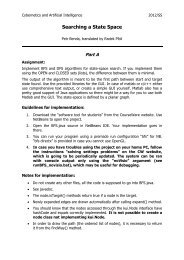
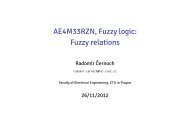



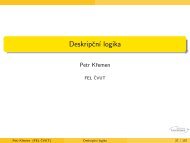

![RANSAC [Fischler, Bolles '81]](https://img.yumpu.com/17549294/1/190x143/ransac-fischler-bolles-81.jpg?quality=85)
